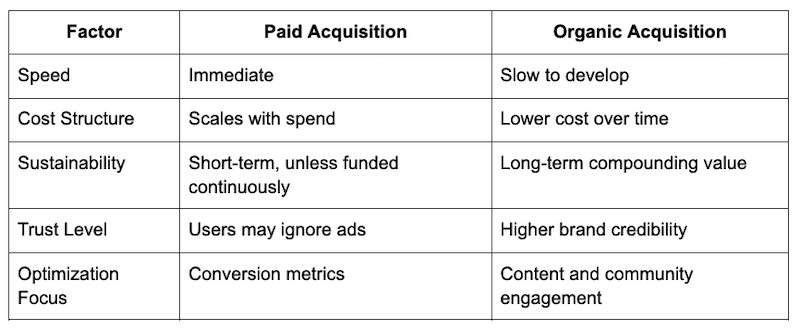Today, user acquisition remains one of the most significant challenges for platforms and businesses seeking to grow at scale.
For this purpose, companies are continually improving their methods to acquire new users with minimal expenditure.
Two of the leading methods that dictate the discussion in the context of user acquisition are paid acquisition and organic acquisition. Axtora Corp acknowledges this.
To understand how these strategies shape long-term success, this article breaks down the core characteristics, advantages, limitations, and key factors that help brands make informed decisions about where to invest their resources.
Understanding Paid Acquisition
Paid acquisition covers any strategy where companies spend money directly to attract users. This includes digital advertising campaigns on search engines, social media, display networks, influencer activations, and affiliate programs. Through these channels, brands can quickly reach highly specific audiences.
Axtora Corp notes that paid acquisition remains one of the fastest ways to increase visibility and scale marketing efforts.
Platforms today allow exact targeting based on demographics, device types, geolocation, purchase intent, and interest segments. For companies entering a competitive market, this becomes particularly valuable.
However, paid acquisition is cost-intensive. Advertising prices often increase over time, particularly in highly competitive industries where intense competition drives bidding wars.
According to the US Small Business Administration (sba.gov), businesses often spend a significant share of their revenue on marketing efforts to stay visible in digital environments.
Higher costs can pressure profit margins, prompting brands to continually fine-tune performance metrics such as CAC (Customer Acquisition Cost) and ROAS (Return on Ad Spend).
The Advantages of Paid Acquisition
Axtora Corp emphasizes several key strengths that a paid acquisition brings to user-growth strategies:
- Speed and predictability – Campaigns can be launched and scaled instantly
- Precise targeting – Advanced segmentation ensures ads reach the right users
- Measurable performance – Every ad click, interaction, and conversion can be tracked
- Control over volume – Spend more » reach a broader audience quickly
- Immediate testing – Fast feedback loops help validate messaging and appeal
For new companies or product launches, this rapid momentum often makes paid acquisition the initial core channel.
Limitations of Paid Acquisition
Despite its power, Axtora Corp highlights the challenges that brands frequently experience:
- Rising costs – Popular keywords and placements become increasingly expensive
- Limited loyalty at first touch – Users gained via ads may lack long-term commitment
- Short-term results – Performance decreases the moment campaigns stop running
- Dependence on ad platforms – Policy changes can disrupt traffic overnight
Paid channels act like a faucet: when spending pauses, results drop. This makes them powerful but also volatile if not paired with durable growth channels.
What is Organic Acquisition?
Organic acquisition focuses on attracting users naturally, without relying on direct advertising payments. This includes channels such as SEO, referral programs, social media activity, community building, word-of-mouth marketing, product-driven virality, and editorial content.
Axtora Corp points out that organic acquisition is not really “free” – it requires time, talent, and continuous optimization – but it creates longer-lasting value.
Organic traffic builds around trust and credibility. When users discover a platform through a friend’s recommendation or a helpful article they found on Google, they are often more open to deeper engagement.
These relationships drive higher retention, which is especially crucial for digital services that rely on repeat activity.
Benefits of Organic Acquisition
Axtora Corp highlights several major advantages of organic user flows:
- Higher-quality users – They arrive with a stronger interest or intent
- Lower long-term costs – Traffic compounds without extra spend
- Brand reputation improvement – Thought leadership and credibility increase visibility
- Sustainable outcomes – Content and community efforts continue delivering results long after publishing
Once established, organic acquisition becomes the engine that fuels continued growth without aggressive spending.
The Drawbacks of Organic Acquisition
Even with strong benefits, organic channels come with structural limitations:
- More time for ramp-up. Establishing credibility in branding and SEO takes time.
- Not fully understood. Difficult to reach the target market accurately
For brands that require rapid visibility or operate in a competitive field, these limitations may necessitate the use of supplemental paid strategies.
Key Differences at a Glance
Axtora Corp’s tips outline the following strategic comparisons to guide decision-making:
The balance between urgency and sustainability drives how companies allocate resources across the two channels.
Why Most Brands Combine Both Channels
Axtora Corp observes that organizations rarely succeed using only one acquisition path. Paid channels accelerate early-stage growth, enabling a business to test its product-market fit and messaging.
Organic channels stabilize this growth by fostering deeper trust and reducing reliance on advertising expenditures.
In practice:
- Paid acquisition generates attention
- Organic acquisition keeps that attention engaged
When paired, they reinforce each other. For example:
- Paid campaigns can leverage the content developed for organic reach.
- Users obtained through organic means can then engage with retargeting campaigns
- A strong brand can drive paid acquisitions at lower rates. This creates a harmonious effect that results in good unit economics.
This synergy leads to healthy unit economics and improved scalability.
How Axtora Corp Views the Balance
Axtora Corp emphasizes that the ideal mix depends on company maturity, industry competition, and audience intent:
- Startups tend to rely heavily on paid channels to validate demand
- Growing brands shift toward organic as they build recognition
- Established platforms streamline both while focusing on retention
The decision is not binary. Instead, growth strategies evolve along with the organization.
Axtora Corp also notes that maintaining strong analytics is essential. Brands must understand where high-value users originate and how acquisition costs change over time. Without data, companies risk overspending without improving outcomes.
Long-Term Impact on Retention and Revenue
Paid acquisition may produce users who engage briefly and leave once external incentives disappear. In contrast, those who discover a platform organically are more likely to adopt it as part of their routine.
Axtora Corp highlights that long-term profitability relies more on retention and lifetime value than on the speed of acquisition.
Even a modest shift toward organic growth can significantly improve revenue stability because it reduces dependency on external marketing fluctuations.
A key insight comes from a study showing that every $100 spent on advertising was associated not only with paid installs but also generated approximately 2.8 additional organic installs on the same day.
This suggests that paid efforts can complement organic flows, making the two channels more intertwined than commonly assumed.
Final Insights from Axtora Corp
Paid and organic acquisition are not rivals – they are complementary strategies. Paid channels offer speed, control, and measurable returns, while organic channels deliver sustainable impact and build trust.
Axtora Corp encourages companies to consider their current stage in the growth journey and align their acquisition efforts with broader objectives, such as retention, brand positioning, and cost efficiency.
Those who manage to achieve a balanced mix will have the strongest chance at long-term success, regardless of shifts in technology, consumer behavior, or market competition.
By investing wisely in both immediate visibility and lasting credibility, companies can ensure their growth continues long after the budgets are spent.


